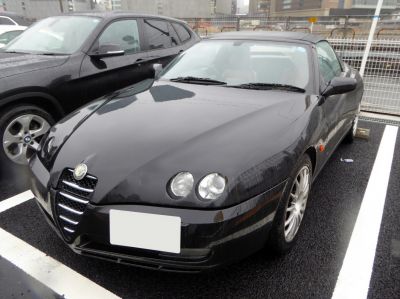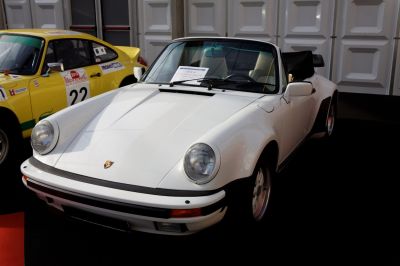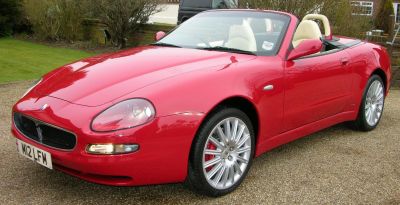 1988 Porsche 911 Targa (Type 930) Dimensions, Size & Specs
1988 Porsche 911 Targa (Type 930) Dimensions, Size & SpecsMeasurements of the 1988 Porsche 911 Targa, engineered for optimal performance and comfort
| Dimensions | |
|---|---|
| Length: | 4291 mm168.9 in14.1 ft |
| Width: | 1775 mm69.9 in5.8 ft |
| Height: | 1310 mm51.6 in4.3 ft |
| Ground Clearance: | 130 mm5.1 in0.4 ft |
| Tire Specifications | |
| Rims Sizes: | 16-inch rims:
|
| Tire Sizes: |
|
The Porsche 911 Targa (Type 930) from the late 1980s represents a classic blend of sporty performance and unique open-top design. Produced between 1987 and 1989, this generation of the iconic 911 series features a distinctive cabriolet style with a fixed roll bar and a removable roof panel, offering a balance between coupe rigidity and convertible freedom. The 1988 model year exemplifies this design ethos with precise dimensions that reflect the car's sporty yet elegant footprint. Measuring 4291 mm (169 inches) in length, the 911 Targa maintains a compact yet aerodynamic profile. Its width extends to 1775 mm (69.9 inches), providing stability and road presence without excessive bulk. The vehicle's height stands at 1310 mm (51.6 inches), contributing to its low-slung, aggressive stance that enhances handling performance. Ground clearance is notably low at 130 mm (5.1 inches), which improves aerodynamics and cornering abilities but requires careful navigation over uneven road surfaces. The Type 930 rides on wheels sized 9J x 16 at the front and 7J x 16 at the rear, paired with tires measuring 205/55 R16 at the front and wider 245/45 R16 at the rear. This staggered tire setup optimizes traction and handling dynamics, characteristic of Porsche’s focus on driving precision. Overall, the Porsche 911 Targa (Type 930) is a quintessential example of late-80s sports car engineering that combines compact, well-proportioned dimensions with the open-air experience. Its size and specifications not only reflect its performance capabilities but also contribute to its timeless appeal among car enthusiasts and collectors.
Discover the standout features that make the 1988 Porsche 911 Targa a leader in its class
Have a question? Please check our knowledgebase first.
The 1988 Porsche 911 Targa (Type 930) has a length of 4291 mm (approximately 168.9 inches), a width of 1775 mm (about 69.9 inches), and a height of 1310 mm (roughly 51.6 inches). These compact dimensions contribute to the car’s distinctive sports car profile, providing a low center of gravity and aerodynamic efficiency reminiscent of classic 911 design. Its relatively narrow width compared to modern sports cars reinforces the agile and nimble driving experience that Porsche 911s are known for. With these dimensions, the Type 930 remains a manageable size for city driving and parking while offering an iconic presence on the road.
The 1988 Porsche 911 Targa (Type 930) features a ride height or ground clearance of 130 mm (approximately 5.1 inches). This low ground clearance is characteristic of sports cars designed for enhanced aerodynamics and improved handling through reduced air resistance and a lower center of gravity. Compared to typical sports cars, this clearance places it firmly in the low-slung category, allowing for better road grip and cornering performance but requiring caution over speed bumps or uneven road surfaces. The low clearance complements the car’s performance-oriented suspension and chassis tuning, tailored specifically for an optimal driving experience on paved roads and racing circuits.
Yes, the rim and tire sizes significantly affect the 1988 Porsche 911 Targa's performance. This model is equipped with front rims sized 9J x 16 and rear rims 7J x 16, paired with front tire sizes 205/55 R16 and rear tires 245/45 R16. Such staggered tire setup, with wider rear tires, enhances traction at the rear-wheel-drive 911, providing better grip during acceleration and cornering. The 16-inch rims are characteristic of the late 1980s sports cars, offering a good balance between ride comfort and handling precision. These sizes maintain the integrity of the suspension geometry and brake clearances, supporting the car’s dynamic driving characteristics while retaining responsiveness on both highways and winding roads.
Although the exact curb weight for the 1988 Porsche 911 Targa (Type 930) is not specified here, this model traditionally weighs approximately 1350 to 1400 kilograms (roughly 2975 to 3086 pounds) depending on options and market specifications. This lightweight design, relative to many modern sports cars, contributes substantially to its agility, acceleration, and handling characteristics. Being relatively light allows for quick responsiveness to driver inputs, sharp cornering, and overall sportier driving behavior. Additionally, the weight distribution, typically a rear-engine layout, plays a key role in driving dynamics, influencing traction and balance through curves and at high speeds.
With dimensions of 4291 mm (16.9 feet) in length, 1775 mm (5.8 feet) in width, and 1310 mm (4.3 feet) in height, the 1988 Porsche 911 Targa (Type 930) is well-suited to fit inside a standard residential garage. Most garages have interior widths around 2.4 to 3 meters (approximately 8 to 10 feet) and lengths around 5.5 to 6 meters (roughly 18 to 20 feet), so the 911 Targa comfortably fits within those parameters. Its low height is not a concern in standard garages, and its narrower width compared to many modern performance cars makes parking and maneuvering easier. This makes the 911 Targa very practical for owners who want daily usability alongside classic sports car excitement.
The 1988 Porsche 911 Targa (Type 930) represents an evolution rather than a complete redesign of the 911 platform used in earlier models such as the 1970s and early 1980s versions. Dimensionally, it maintained a very similar length, width, and height to its predecessor with only slight modifications for aerodynamic and styling purposes. Compared to earlier 911 Targas, the Type 930 may show incremental increases in width and subtle changes in height, reflecting the adaptation of wider tires and updated bodywork. Overall, the continuity in size preserves the classic 911 silhouette, with improvements targeted more towards performance, comfort, and safety rather than significant dimensional change.
When compared to its contemporaries like the Ferrari 328 or the Jaguar XJ-S Cabriolet, the 1988 Porsche 911 Targa (Type 930) is more compact in length and height but similar in width. Its length of 4291 mm (168.9 inches) is shorter than many grand tourers, while its 1775 mm (69.9 inches) width aligns closely with other performance cars of the late 1980s. Its lower height of 1310 mm (51.6 inches) gives it a more aggressive and sporty stance compared to taller competitors. The Type 930’s compact and lightweight design focuses on sharp handling and agility rather than sheer size, making it a standout choice for enthusiasts favoring driver engagement over grand touring space.
The 1988 Porsche 911 Targa (Type 930) typically features a fuel tank capacity of approximately 64 liters (around 17 gallons). Fuel consumption varies depending on driving style and conditions but generally ranges from about 12 to 15 liters per 100 kilometers (approximately 19.6 to 15.7 miles per gallon US). This relatively high fuel consumption reflects the spirited performance of the turbocharged flat-six engine, characteristic of the Type 930 variant. Owners often find that this balance between performance and fuel economy is acceptable given the exhilarating driving experience, although it is less efficient compared to modern sports cars with advanced fuel-saving technologies.
The 1988 Porsche 911 Targa (Type 930) features a distinctive removable roof panel combined with a fixed roll bar, creating a unique blend between a convertible and coupe. This Targa roof mechanism allows drivers to enjoy open-air motoring while retaining structural rigidity and rollover protection not found in full convertibles. The roof panel is manually removable, stored in the front trunk area when off, which adds some convenience. This setup provides a classic sports car experience with open-top driving enjoyment balanced against safety and security standards. The Targa design's character and practicality have made it an enduring favorite among 911 enthusiasts.
The 1988 Porsche 911 Targa (Type 930) is powered by a robust turbocharged 3.3-liter flat-six engine. This powertrain delivers around 300 horsepower and 412 Nm (304 lb-ft) of torque, offering strong acceleration performance consistent with Porsche’s reputation for sporty driving dynamics. The car typically accelerates from 0 to 100 km/h (0 to 62 mph) in approximately 4.8 seconds, which was very competitive for its time. The rear-wheel-drive layout combined with a precise five-speed manual transmission enhances driver engagement and control. The Type 930’s performance credentials complement its iconic styling, making it a desirable combination of classic looks and thrilling driving experience.
Discover similar sized cars.

| Production: | 2003-2004 |
|---|---|
| Model Year: | 2003 |
| Length: | 4299 mm169.3 in |
| Width: | 1776 mm69.9 in |
| Height: | 1315 mm51.8 in |

| Production: | 1995-2003 |
|---|---|
| Model Year: | 1995 |
| Length: | 4285 mm168.7 in |
| Width: | 1780 mm70.1 in |
| Height: | 1320 mm52.0 in |

| Production: | 1987-1989 |
|---|---|
| Model Year: | 1988 |
| Length: | 4291 mm168.9 in |
| Width: | 1775 mm69.9 in |
| Height: | 1310 mm51.6 in |

| Production: | 2001-2007 |
|---|---|
| Model Year: | 2002 |
| Length: | 4303 mm169.4 in |
| Width: | 1822 mm71.7 in |
| Height: | 1305 mm51.4 in |
